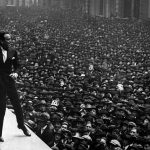4 Tips For Dropping Quotable One-Liners Into Your Next Big Talk
I worked with the CEO of a major chemicals corporation many years ago, and I asked him how he communicates with such a huge organization.
“Anett,” he told me, “if I got on a plane and traveled every day, I still couldn’t visit every facility. So when I go there, I need that memorable line. I need that quote that they can take home and say to their family, ‘This is what the CEO said to me today.’ My quote is my personal handshake with every member of my company, everywhere in the world.”
You may not oversee hundreds of facilities all over the world, but you probably still need to get your message across with people you don’t have a chance to sit and chat with personally—whether it’s the media, team members in meetings, or fellow industry folk at conferences. Here’s what it takes to make sure what you say is quotable and memorable.
1. It’s Got To Be Pithy
Quotable one-liners need to be pithy in order to be quotable. The goal is to pack as much meaning into as few words as possible. Think in terms of headlines, not paragraphs. If your message is complex, people are much less likely to remember it and pass it on to other people.
Don’t just think hard about what your point is (though do that too!), think about how you can express it in a sharp turn of phrase or clever line that will stick in the minds of your listeners. And don’t be afraid of a little strategic repetition. If they hear the same few words over and over again, they’ll likely start using those words as well.
For example, when Indra Nooyi took over as CEO of PepsiCo, she talked about “performance with purpose”—repeatedly. As I worked with PepsiCo leaders in Dubai, Latin America, China, and elsewhere, I heard that phrase over and over again.
You might dismiss that as a zingy corporate catchphrase, but it distilled everything Nooyi wanted to impress on her organization into three short words; it was effective. By keeping it short and pithy, she packed a powerful punch.
2. Use Powerful Imagery
If you can find a way to illustrate your point in a vivid, visual way, you’re more likely to be quoted. In a recent CNN Money article about problems with Exxon Mobil’s stock, Tom Sanzillo, director of finance at the Institute for Energy Economics and Financial Analysis, was quoted as saying, “There are more red flags than a 10-car pileup at a NASCAR race.”
Sanzillo uses a vivid image to get his point across—you can actually see the fluttering flags and the smoldering crash site. And make no mistake: He was quoted by the reporter not only because of his opinion, but because he packaged his idea using imagery. It doesn’t take much, either. But if you can paint a quick, effective image, your messages are much more likely to be retained and transmitted.
3. Drop A Memorable Data Point
Big data dumps can make for painfully dull presentations. But there’s no substitute for sharing a statistic that’s simple but powerful. You never want to get too bogged down in data—your listeners’ eyes will glaze over—but an intriguing data point can be very memorable.
For example, Audrey Choi, CEO of the Institute for Sustainable Investing at Morgan Stanley was recently quoted by Bloomberg as saying, “Really significantly, [millennials are] twice as likely to invest in a stock or a fund if sustainability is part of the value-creation thesis.”
Not the most pithy sentence, but what makes it so quotable is that “twice as likely” is such a simple but powerful data point. The finding that millennials are interested in investing in sustainable companies isn’t that surprising, but that they’re twice as likely to actually put their money into those businesses is really compelling. It’s why the journalist couldn’t resist including that line in her article.
4. Make Sure It’s Relevant
Finally, getting quoted is like catching a wave—you have to connect with what’s happening in the moment. Nooyi’s “performance with purpose” phrase resonated with global audiences who are becoming more concerned about sustainability. So if you want to be quoted, you need to connect with what people care about at the moment.
Before you speak, think about how you can frame what you want to say in a way that might resonate most with your audience. That doesn’t mean pandering to whatever’s trending. It just requires you to understand how your idea fits into the mix of ideas that’s already out there. After all, for an idea to matter, it has to matter to other people. That’s what relevance is all about.
Whatever you do, don’t wait for moments of inspiration to deliver those catchy one-liners. If you want your message to get quoted, you may need to start talking like it.
Fast Company , Read Full Story
(7)














